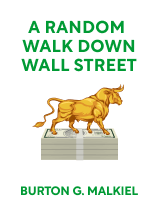

This article is an excerpt from the Shortform book guide to "A Random Walk Down Wall Street" by Burton G. Malkiel. Shortform has the world's best summaries and analyses of books you should be reading.
Like this article? Sign up for a free trial here .
What is the best investment strategy, according to economist Burton Malkiel? Why are index funds likely your best bet?
In A Random Walk Down Wall Street, economist Burton Malkiel reveals his best investment strategy. If you only take one thing away from the book it should be this: Investors are better off putting their money in a passively managed index fund—a total market index fund, to be precise—than trading stocks themselves or investing in an actively managed mutual fund.
Find out more about Burton Malkiel’s best investment strategy below.
What Is the Best Investment Strategy?
In A Random Walk Down Wall Street, Burton Malkiel details the best investment strategy for long-term success.
This economic classic is an accessible guide to financial markets for the individual investor. Written by Burton Malkiel, an economist (Ph.D., Princeton) with years of practical experience on Wall Street, the book covers everything from buying life insurance to pricing commodities to understanding credit default swaps. But, for the most part, Malkiel’s focus is on common stocks—shares in individual firms—and the stock market.
Although Malkiel offers a wealth of information that investors can use to make individual investments on their own, he repeatedly emphasizes the advantages of index investing. According to Malkiel, the best investment strategy is to put your money in a passively managed index fund (specifically a total market index fund). This is better than trading stocks themselves or investing in an actively managed mutual fund.
For example, an investor who put $10,000 into an S&P 500 Index Fund in 1969 would have had a $1,092,489 portfolio in April 2018 (assuming all dividends were reinvested). An investor who put the same amount of money into an actively managed fund would’ve only had $817,741.
Ideal for the prospective investor who wants to take advantage of stock-market returns but isn’t interested in specifics, the autopilot strategy consists of purchasing broad index mutual funds or exchange-traded funds (ETFs) rather than individual stocks or industries.
(Some of the tax differences between traditional mutual funds and ETFs are described below, but the general rule of thumb is: If you have a large lump sum that you want to invest in index funds, ETFs are generally the most advantageous choice. If you’re going to be purchasing index fund shares in smaller amounts over a longer period of time, traditional mutual funds are your best bet.)
The autopilot strategy is Malkiel’s preferred method of investing. No matter how knowledgeable or engaged the investor, Malkiel advises building the core of a portfolio around index funds and only making active bets with excess cash.
The rationale behind the autopilot strategy is simple: Long-run returns of the S&P 500 Stock Index, which represents almost three-quarters of the value of the entire stock market, typically beat returns on portfolios designed by the most seasoned investment professionals. In short, if you were to invest in a mutual fund that holds a weighted representation of the stocks in the S&P 500, you would do better on average than trying to pick winners yourself or entrusting your money to an investment advisor.
Not only are returns better with broad market index funds, fees and expenses tend to be, too. Because index funds are passively managed—that is, they adjust their holdings more or less automatically on the basis of market values—they tend to have extremely low expense ratios (.0005% or less for some). And because index funds only trade to rebalance their weights, they incur low trading costs as well.
While the S&P 500 index funds are generally the most popular type of index fund—and they will outperform actively managed funds on average—Malkiel actually recommends that investors choose a total market index fund over an S&P 500 fund. This is because the S&P 500 index excludes smaller stocks that, historically and on average, have outperformed larger ones. Try to find a fund indexed to the Russell 3000, the Wilshire Total Market Index, the CRSP Index, or the MSCI US Broad Market Index.
Of course, as Modern Portfolio Theory teaches (see Chapter 8), diversification is the key to a successful portfolio. But one need not abandon index funds to diversify: There are funds that track REIT, corporate bonds, international capital, and emerging market indices.
A Sample Index-Fund Portfolio
Here are some specific funds you might consider in each of the primary asset classes (cash, bonds and bond substitutes, REITs, and stocks). Consult the age-dependent allocations in the previous chapter to determine how much of each asset you should hold.
- Cash
- Fidelity Money Market Fund (FXLXX) or Vanguard Prime Money Market Fund (VMMXX)
- Bond and Bond Substitutes
- 7.5% US Vanguard Long-Term Corporate Bond Fund ETF (VCLT) or iShares Corporate Bond ETF (LQD)
- 7.5% Vanguard Emerging Markets Government Bond Fund (VCAVX)
- 12.5% Wisdom Tree Dividend Growth Fund (DGRW) or Vanguard Dividend Growth Fund (VDIGX)
- Real Estate
- Vanguard REIT Index Fund (VGSIX) or Fidelity Spartan REIT Index Fund (FRXIX)
- Stocks
- 27% US Stocks Schwab Total Stock Market Index Fund (SWTSX) or Vanguard Total Stock Market Index Fund (VTSMX)
- 14% Developed International Markets Schwab International Index Fund (SWISX) or Vanguard International Index Fund (VTMGX)
- 14% Emerging International Markets Vanguard Emerging Markets Index Fund (VEIEX) or Fidelity Spartan Emerging Markets Index Fund (FFMAX)
A short-term bond might be substituted for one of the money-market funds, and investors might include some Treasury inflation-protected securities (TIPS) among their bond holdings.’
A Case For Index Funds
No matter what, for large sums like your retirement savings, a diverse portfolio of index funds is the strategy that Malkiel recommends. That said, some investors—for example, those with a taste for gambling—will find indexing an entire portfolio boring and may want to try their luck picking winners. Malkiel advises that thrillseekers only speculate with secondary monies that they can afford to lose, and that they follow four key principles.
Unfortunately for portfolio managers, academics have compared managers’ returns with those provided by a market index fund—a mutual fund with holdings that replicate a market index—and found that portfolio managers simply aren’t worth the money. That is, no investor can do better in the long run than a market index fund.
All in all, Malkiel advises investors to build their portfolios around a broad market index fund. If a particularly engaged investor is willing to accept a less reliable risk-return ratio, that investor might invest moderately in a blended fund with low expenses and fees.
Is It Really the Best Investment Strategy?
Some argue that index funds aren’t the best investment strategy, for reasons stated below.
As of 2018, 40% of the amount invested in ETFs and mutual funds was in index funds. In response to the rapidly growing popularity of indexing, firms that rely on the fees and commissions attached to actively managed portfolios have criticized the practice. They believe that with greater indexing will come two issues: (1) prices will no longer reflect new information, because there will be no active investors to take advantage of, say, a positive clinical result for a new pharmaceutical; and (2) index-fund providers like Vanguard, Blackstone, and Fidelity will garner outsize ownership (and thus influence) in publicly traded companies.
In response to (1), Malkiel notes that there will always be active traders seeking arbitrage—that is, price–value disjunction—opportunities. Consider the example just above: If a pharmaceutical company develops a new therapeutic for cancer, is it conceivable that no investors will buy the stock and bid up the price? Of course not.
As for (2), anti-competitive or collusive behavior on the part of the major index-fund providers is illogical. For example, say Vanguard ends up with a majority stake in America’s airline companies and decides to use its shareholder vote to raise ticket prices. A move like this may raise revenues for airline stocks, but it will reduce revenues for companies who rely on cheap airfare for business travel. Given index funds’ index-wide holdings, an intervention in one sector will likely be offset by effects in other sectors.
Simply put, as far as Malkiel is concerned, index funds are a clear positive for individual investors—and for society as a whole. This is why he argues they are the best investment strategy.

———End of Preview———
Like what you just read? Read the rest of the world's best book summary and analysis of Burton G. Malkiel's "A Random Walk Down Wall Street" at Shortform .
Here's what you'll find in our full A Random Walk Down Wall Street summary :
- A comprehensive and entertaining introduction to the world of finance
- Practical investment principles that work for every skill level
- The advantages of index investing






